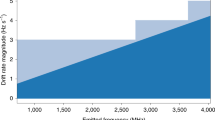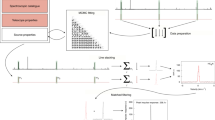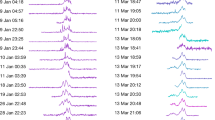Abstract
MANY scientists believe that intelligent life is common in our Galaxy1–6 and that electromagnetic waves are the most practical means of communication7,8. Even equipment of a terrestrial standard can produce communication within a distance of 100 light yr. Several searches for interstellar signals have been proposed; however, difficulty arises in the selection of technical parameters such as frequency and coding. Among these, the selection of frequency is the most important. We propose here that the 4,829.659-MHz line frequency of the 111→110 rotational transition of formaldehyde is a plausible frequency.
This is a preview of subscription content, access via your institution
Access options
Subscribe to this journal
Receive 51 print issues and online access
$199.00 per year
only $3.90 per issue
Buy this article
- Purchase on Springer Link
- Instant access to full article PDF
Prices may be subject to local taxes which are calculated during checkout
Similar content being viewed by others
References
Drake, F. D. paper presented at the Space Science Board, National Academy of Sciences Conf, on Extraterrestrial Intelligent Life, Green Bank (1959).
Cameron, A. G. W. in Interstellar Communication (ed. Cameron, A. G. W.) 107–110 (Benjamin, New York, 1963).
Bracewell, R. N. in Interstellar Communication (ed. Cameron, A. G. W.) 232–242 (Benjamin, New York, 1963).
von Hoerner, S. in Interstellar Communication (ed. Cameron, A. G. W.) 272–286 (Benjamin, New York, 1963).
Kreifeldt, J. G. Icarus 14, 419–430 (1971).
Wertz, J. R. J. Br. Interplanet. Soc. 29, 445–464 (1976).
Cocconi, G. & Morrison, P. Nature 184, 844–846 (1959).
Drake, F. D. Physics Today 14, 40–42 (1961).
Palmer, P., Zuckerman, B., Buhl, D. & Snyder, L. E. Astrophys. J. Lett. 156, L 147–150 (1969).
Houk, N. & Cowley, A. P. University of Michigan Catalogue of Two-Dimensional Spectral Types for the HD Stars, Vol. 1. (University of Michigan, 1975).
Author information
Authors and Affiliations
Rights and permissions
About this article
Cite this article
MORIMOTO, M., HIRABAYASHI, H. & JUGAKU, J. Preferred frequency for interstellar communications. Nature 276, 694–695 (1978). https://doi.org/10.1038/276694a0
Received:
Accepted:
Issue Date:
DOI: https://doi.org/10.1038/276694a0
Comments
By submitting a comment you agree to abide by our Terms and Community Guidelines. If you find something abusive or that does not comply with our terms or guidelines please flag it as inappropriate.



